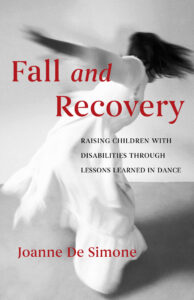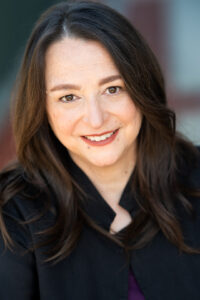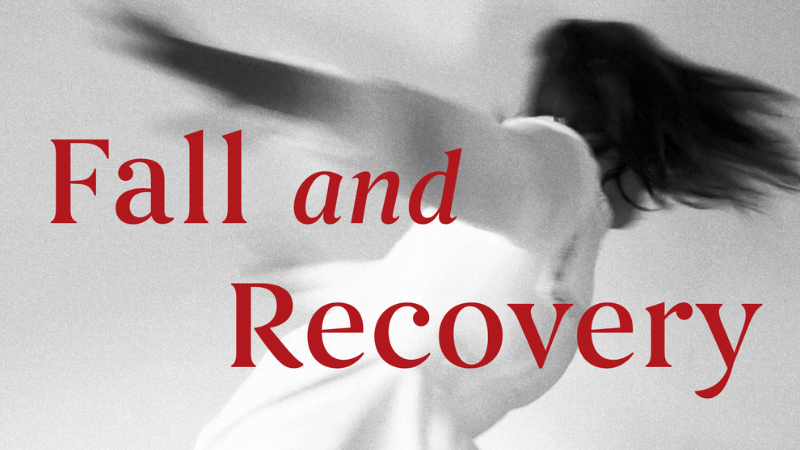 In “Fall and Recovery: Raising Children with Disabilities through Lessons Learned in Dance” (She Writes Press, Sept. 17, 2024), author Joanne De Simone delves into the transformative power of dance in navigating the challenges of parenting children with disabilities.
In “Fall and Recovery: Raising Children with Disabilities through Lessons Learned in Dance” (She Writes Press, Sept. 17, 2024), author Joanne De Simone delves into the transformative power of dance in navigating the challenges of parenting children with disabilities.
When the pediatrician placed the measuring tape around her infant’s head and noted, “His head is a little small,” Joanne knew that motherhood wouldn’t be as she had dreamt. Even as a special educator, Joanne wasn’t prepared to raise a child with a life-limiting brain malformation. Nor was she ready for the compounded pain and alienation that came when her second son was diagnosed with autism. But the struggle to balance her sons’ medical and educational challenges drove Joanne to reconnect with the lessons she learned as a modern dancer – and there she found enlightenment.
Inspired by her experience performing José Limón’s “There Is a Time,” based on Ecclesiastes 3, each chapter of “Fall and Recovery” details a dance lesson and the dichotomy of parenting children with disabilities. Over time, Joanne discovers that surviving motherhood isn’t a matter of strength, bravery, or faith. It’s a matter of linking your past experiences and creating your own purpose. It’s realizing that we live simultaneously in love and grief. In the end, dance teaches Joanne not only how to move freely through pain but also how to fall and recover.
“Fall and Recovery: Raising Children with Disabilities through Lessons Learned in Dance”
Joanne De Simone | Sept. 17, 2024 | She Writes Press | Memoir
Paperback | 978-1-64742-714-6 | $17.99
E-book | $12.99
About the Author
 Joanne De Simone is a graduate of Hunter College with degrees in dance and special education. After dancing professionally with companies including José Limón and Dianne McIntyre, she dedicated her life to teaching children with disabilities and supporting families. Currently, Joanne is a special education advocate for the Alliance of Private Special Education Schools of North Jersey. Her writing has appeared in the Washington Post, Exceptional Parent Magazine, and the Rumpus, among other publications. She is a contributing author to “Barriers and Belonging: Personal Narratives of Disabilities.” Joanne and her son, Sebastian, were instrumental in a legislative change allowing students with intellectual disabilities to participate in NCAA D3 intercollegiate sports. Joanne has been featured in the Philadelphia Inquirer, on HuffPo Live, CNN, and GMA3. Visit www.Special-EducationMom.com for more information.
Joanne De Simone is a graduate of Hunter College with degrees in dance and special education. After dancing professionally with companies including José Limón and Dianne McIntyre, she dedicated her life to teaching children with disabilities and supporting families. Currently, Joanne is a special education advocate for the Alliance of Private Special Education Schools of North Jersey. Her writing has appeared in the Washington Post, Exceptional Parent Magazine, and the Rumpus, among other publications. She is a contributing author to “Barriers and Belonging: Personal Narratives of Disabilities.” Joanne and her son, Sebastian, were instrumental in a legislative change allowing students with intellectual disabilities to participate in NCAA D3 intercollegiate sports. Joanne has been featured in the Philadelphia Inquirer, on HuffPo Live, CNN, and GMA3. Visit www.Special-EducationMom.com for more information.
Follow Joanne De Simone on social media:
Facebook | Twitter (X) | Instagram
In an interview, Joanne De Simone can discuss:
- The profound challenges of raising two sons with disabilities and the life-changing moment at the pediatrician’s office that reshaped her journey as a mother.
- Why it was important to her to be honest, vulnerable, and unfiltered in sharing her family’s experiences, and how this transparency fosters connection and understanding.
- Her background in special education advocacy and her mission to empower parents navigating the special education system.
- The co-existence of love and grief, and how accepting this duality is essential for emotional resilience.
- The practical difficulties and emotional impact of raising children with disabilities, including feelings of pain and alienation. Plus, her hope that other struggling parents feel less isolated and more understood.
- Her professional dance career and rediscovering how dance taught her valuable life lessons. Plus, how dance provided her solace, strength and enlightenment.
- How each chapter in her book mirrors a dance lesson with the realities of parenting children with disabilities, drawing powerful parallels between the two.
- How performing José Limón’s “There Is a Time” guided her approach to parenting, helping her navigate pain and transform struggles into recovery.
- Her efforts advocating for legislative changes that allow students with intellectual disabilities to participate in NCAA D3 intercollegiate sports, opening new opportunities for inclusivity and recognition.
An Interview with Joanne De Simone
Before we dive into everything else, please introduce yourself and your family.
I’m a former dancer and special educator. I currently work as a special education parent advocate. My husband, John, works in film production. We have two sons. Benjamin was born with a rare brain malformation. He has cerebral palsy, an uncontrollable seizure disorder, and a soul lifting smile. Sebastian is on the autistic spectrum. He’s an accomplished long distance runner with an unflinching ability to see the good in others.
Can you share the moment you realized your motherhood journey would be different from what you anticipated?
When my oldest son was one week old, my husband and I took him to the pediatrician for a check-up. The doctor placed a measuring tape around his head and noted, “His head is a little small.” I knew instantly there was something wrong. I felt an immediate unease in my entire body telling me this journey was going to be unlike anything I’d dreamt.
What was your reaction to your second son’s diagnosis of autism? Did it compound the challenges you were already facing? Or did you feel more prepared?
I had spent a fair amount of time in denial before seeking a clinical diagnosis for Sebastian, so I was prepared for it when it came from the doctor. Prior to the diagnosis, I fought to hide from my and my husband’s observations, which clearly pointed to the fact that Sebastian was on the autism spectrum. It was too much to face and process the unknown future of yet another child. Nothing truly prepares you for the challenges and the stress of raising a child with high medical needs and another with autism. That’s why my experience as a special educator wasn’t enough to manage my version of motherhood.
The tone of your book is honest and vulnerable, sometimes dark yet hopeful. Why was it important to you to share your family’s experiences in this way?
Years ago I wrote an essay for Brain, Child Magazine called “Bury My Son Before I Die.” I discussed my conflict of having a child who might die, doing everything I could to keep him alive, and being terrified about what happens to him if I die first. The piece went viral. I was astonished by how many people reached out to me to share their stories. One parent wrote that for the first time, she didn’t feel like a monster for having all of these same thoughts. Knowing that this mom shared my experience, but shamed herself for having a normal response to a stressful situation broke me. It drove me to write about the difficult moments in the most unfiltered way.
How did your professional background in special education influence your initial approach to raising your children? Do you think that training prepared you to navigate your children’s disabilities?
Having a background in special education allowed me to advocate for my children’s educational needs. There was a tremendous advantage to understanding the law and all the clinical information, but it didn’t prepare me for managing the emotions or the conflict that can come with parenting children with disabilities. It didn’t prepare me for the utter feeling of loneliness.
How did reconnecting with your past as a modern dancer help you navigate the challenges of raising two children with disabilities?
At first, my dance experience helped me with practical issues like doing stretching exercises with Benjamin to manage his tight muscles or teaching Sebastian about dance so he could be more mindful of his movements. Later, I realized that dance lessons could be generalized and used to approach the complex feelings I struggled with. As a dancer my goal was to express a story or feeling through movement. The message of the dance was more important than any one dancer on stage. It wasn’t about me. This mindset is useful when confronting complex medical decisions. When I get caught up worrying about how a decision will affect me and my ability to care for Benjamin, I remember that it’s important to focus on his needs and take myself out of the equation.
What are some specific dance lessons that you found particularly relevant to parenting children with disabilities, and how do these lessons manifest in your day-to-day life?
One of the dance lessons I learned was to live in the movement. It’s a reminder to focus on and enjoy what you’re doing in the present moment. As a parent, it’s so easy to worry about the future. This dance lesson reminds me to live one day at a time and focus on the moment I’m experiencing. Another lesson related to this idea is focusing on the process, not the product. When you choreograph a dance, or write a book, or raise a child, it’s important to focus on making the journey as fulfilling as possible as opposed to fretting about the end result.
In your book, you suggest that surviving motherhood with disabled children isn’t about strength or bravery alone. Can you elaborate on what that means to you?
I think when things don’t work out as we planned, it’s easy to fall into a state of blame, guilt, and regret. I know so many parents who feel like complete failures. I certainly fell into the habit of wondering what I did wrong. Dance taught me that everything connects through space and time. For me, turning a presumed failure into success was a matter of linking my experiences and using my collective knowledge to move forward with purpose, thus limiting regret.
How did you come to terms with the coexistence of love and grief, and how did this realization impact your approach to parenting?
If you watch José Limón’s “There Is a Time,” you will see a community of dancers experiencing all the extremes of life. Looking back at my experience performing the dance and comparing it to the rest of my life, I was struck by the extremes I experienced as a child when my father died on my brother’s wedding day. I was able to accept that extreme opposing feelings are a normal part of life and parenting.
Similarly, how did you cope with the emotional impact of your children’s diagnoses? How did you manage the feelings of pain and isolation that accompanied these challenges?
Any emotional experience requires time to process. I think it’s essential to take the time to acknowledge both the joy and the sorrow that comes with living. Acceptance is not a place you arrive at by ignoring negative feelings. Pain is not an enemy, it’s a messenger. Parents are often told to enjoy every moment of their children’s lives. I don’t think being present and fully attending to the moment should be exclusive to positive experiences. In modern dance gravity is a force used to generate movement. You fall with the direct intention to rise. You must fall to recover.
How old are your sons now? How are they doing?
Benjamin is 25 years old. He is doing well and enjoying life at home now that his formal education is finished. He graduated at the start of Covid so that was a hard transition for everyone. There are still limitations for disabled adults when it comes to post-secondary opportunities especially for adults with complex medical needs. There are a lack of programs and a lack of providers.
Sebastian is 21 years old. He is thoroughly enjoying the independence that college affords him. He’s studying education and hopes to work with children with disabilities. He is also a proud three season NCAA athlete competing in cross country and indoor/outdoor track.
Praise for “Fall and Recovery” and Joanne De Simone
“What’s most evident in the narrative is the love that De Simone and her husband have for their two boys…A moving account of caring and advocating for children with disabilities.”
– Kirkus Reviews
“An unflinchingly honest and beautifully rendered memoir. With breathtaking clarity, the author’s words dance across each page, imbued with love, pain and heart, as she shares the challenges and joys of raising her two special sons.”
— Diana Kupershmit, author of Emma’s Laugh: The Gift of Second Chances
“Joanne De Simone takes the reader on a powerful journey, masterfully weaving lessons learned as a dancer into her experiences as a mother of two children with disabilities. It is beautifully written, heartbreaking, and inspiring. The raw honesty of her storytelling allows the reader to truly understand the complexities of raising children with complicated challenges. ”
— Jesse Torrey, LAC, MA, author of Smiles & Duct Tape
“A memoir of strength, persistence, and—most of all—love. Parenting is never easy, but, as De Simone discovers, raising two children with disabilities can easily knock a mother down. Gracefully weaving the threads of dance, motherhood, and dis- ability through her remarkable journey, De Simone shows us all how to ‘fall with the direct intention to rise.’”
— Karen DeBonis, author of “Growth: A Mother, Her Son, and the Brain Tumor They Survived”
“Heartfelt and engaging, this memoir of raising children requiring vastly varying degrees of care and advocacy delicately threads blurred, complicated, and demanding lines. With the best parts of quiet compassion, noiseless rage, and complete, unconditional acceptance, Joanne De Simone depicts a specific, sweeping motherhood that soars far above unrelenting daily demands. Through the lens of her foundation in dance, Joanne embraces the gift of the children in her home, not those who once occupied her imagination.”
— Lisa Romeo, author of “Starting With Goodbye: A Daughter’s Memoir of Love After Loss”
“The Limón technique centers the defined poles of ‘fall’ and ‘recovery.’ However, the dance is what happens in the undefined, unpredictable, unsettled, and magnificently alive moment-to- moment between the two. Wholly embodying this in-between mercurial time/space, Joanne De Simone writes—as she danced, as she lives—with raw honesty, brilliance, and seemingly boundless generosity. Joanne’s is a fierce grace; not delicately poised above, but rather in a visceral and dynamic intimacy with the gravity, heartfelt vulnerability, and wonder of person and parenthood.”
— Steuart Gold, somatic psychotherapist and former Limón Company dancer
Download press kit and photos

A former award-winning journalist with national exposure, Marissa now oversees the day-to-day operation of the Books Forward author branding and book marketing firm, along with our indie publishing support sister company Books Fluent.
Born and bred in Louisiana, currently living in New Orleans, she has lived and developed a strong base for our company and authors in Chicago and Nashville. Her journalism work has appeared in USA Today, National Geographic and other major publications. She is now interviewed by media on best practices for book marketing.


